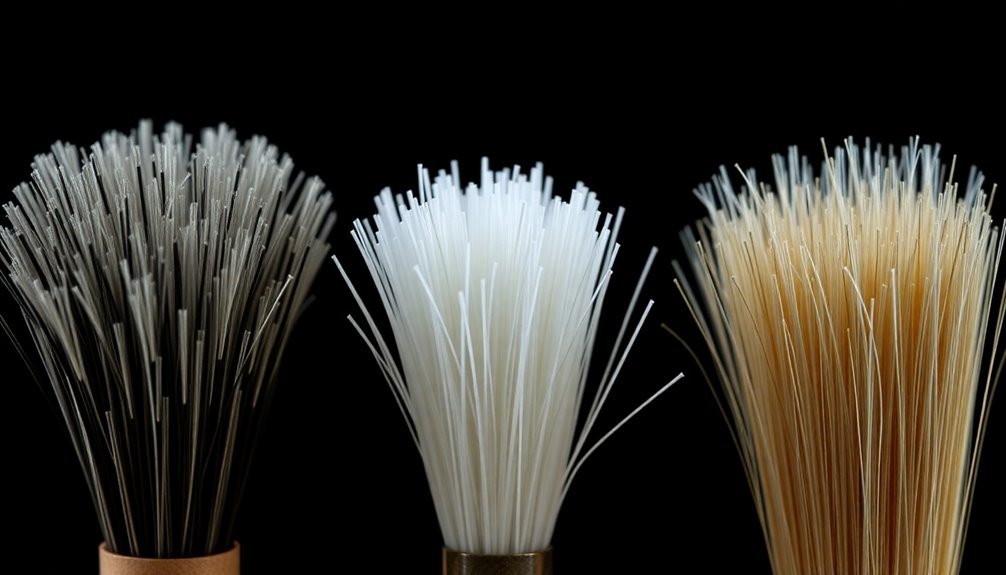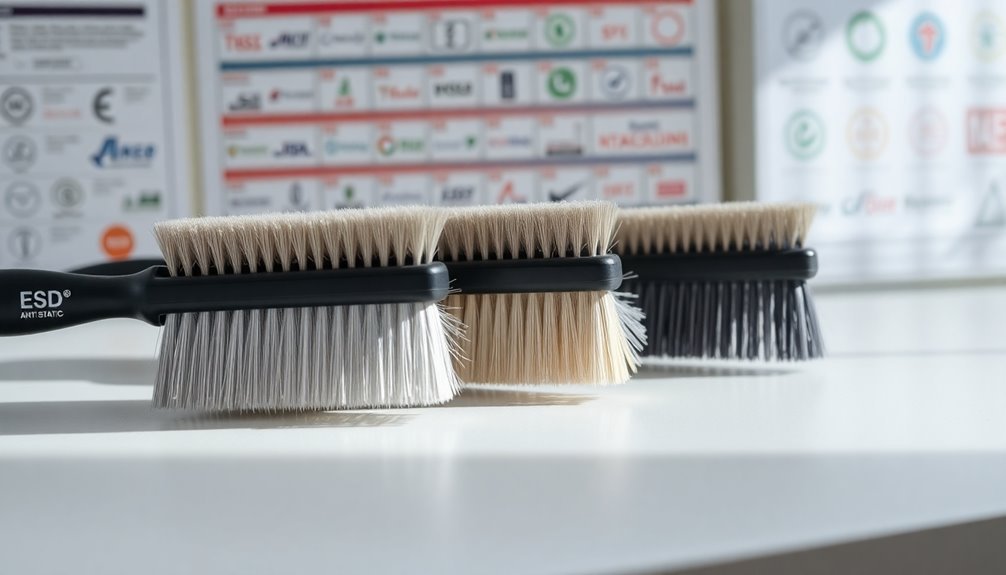When choosing anti-static brushes for PCBs, you'll want to focus on three key factors for effective cleaning results. First, select bristles made with conductive materials like carbon-infused synthetics or natural fibers that provide static neutrality and gentle cleaning action. Second, confirm the handle features ergonomic design and conductive or dissipative materials that meet ESD safety requirements. Third, verify the brush meets industry safety standards like IEC-61340-1-5 and ANSI/ESD S20.20 for proper static control. Understanding these essential elements will help you make a more informed decision that protects your sensitive electronic components.
Evaluate Bristle Material Properties

When selecting anti-static brushes for PCB cleaning, you'll need to understand the key properties of different bristle materials. Each material type offers distinct advantages and limitations that directly impact your cleaning effectiveness and component safety.
Natural fibers provide excellent static neutrality, making them suitable for basic PCB cleaning tasks. Horse hair bristles offer exceptional cleaning capabilities since they become static dissipative when wet. You'll find they're gentle on delicate surfaces and won't generate harmful static charges. However, they aren't ideal for cleanroom environments and may not withstand harsh chemicals.
Synthetic fibers, particularly those with small diameters, offer good static dissipation properties. You'll want to evaluate nylon or carbon fibers if you need stronger cleaning action while maintaining static control. These materials also provide better chemical resistance than natural fibers.
Metal bristles deliver superior conductivity and can be grounded effectively. If you're dealing with stubborn debris or need aggressive cleaning, brass or stainless steel bristles might be your best choice. Remember that metal bristles must be properly grounded to prevent static buildup.
Evaluate your specific environmental factors when choosing bristle materials. You'll need to account for temperature conditions, chemical exposure, and any cleanroom requirements.
Don't forget to assess the material's outgassing properties if you're working in sensitive environments.
Assess Handle Design Features
Beyond bristle material selection, the handle design of your anti-static brush plays a major role in cleaning effectiveness and user comfort. When selecting an anti-static brush, you'll want to focus on handles that provide ergonomic grip features to reduce fatigue during extended PCB cleaning sessions.
Look for lightweight designs that won't strain your wrist during repetitive movements.
For material choice, avoid wood handles as they're unsuitable for cleanroom environments. Instead, opt for conductive metal or dissipative plastic handles that meet ESD safety requirements.
Quality handles include ESD-safe carbon fibers that effectively dissipate static charges during use.
You'll find cylindrical handles work well for broad surface cleaning, while conical or flat profiles offer better control for detailed work in tight spaces.
Consider your specific application needs when evaluating handle durability. If you're working with harsh cleaning agents, choose handles with chemical resistance properties.
The handle should be appropriately sized for your hand and application type. Don't forget to verify that your chosen handle design is compatible with your cleanroom or industrial environment specifications.
Many manufacturers offer customization options if standard handles don't meet your exact requirements for size, shape, or material composition.
Consider Safety Compliance Standards

Safety compliance forms the backbone of any effective anti-static brush selection process. You'll need to guarantee your chosen brushes meet IEC-61340-1-5 International Standards and carry ANSI/ESD S20.20 certification for reliable static control. Your brushes must maintain surface resistivity between 10^4 and 10^8 ohms to effectively dissipate static charges that could otherwise reach dangerous levels of up to 30,000 volts. Natural horsehair bristles offer excellent static control while being gentle on delicate components.
| Standard | Requirement | Purpose |
|---|---|---|
| IEC-61340-1-5 | International compliance | Global static control standards |
| ANSI/ESD S20.20 | Certification validation | Antistatic efficacy verification |
| Surface Resistivity | 10^4 – 10^8 ohms | Static charge dissipation |
| Material Content | 20% conductive carbon | Safe charge transfer |
| Chemical Resistance | IPA compatible | Maintaining integrity |
When selecting your ESD brush, verify that both handles and bristles use approved conductive or static-dissipative materials. The brush composition should include conductive carbon particles and anti-static polymer filaments to guarantee proper static dissipation. Don't forget to check for chemical resistance, particularly against cleaning agents like IPA, as this affects long-term performance and safety compliance. Remember, these standards aren't just guidelines – they're essential safeguards for protecting your sensitive electronic components from costly ESD damage.
Frequently Asked Questions
How Often Should Anti-Static Brushes Be Replaced for Optimal Performance?
You'll need to replace your anti-static brushes annually if you're cleaning around 2,000 PCBs daily. However, check for wear signs like decreased effectiveness or visible damage, and replace sooner if needed.
Can Anti-Static Brushes Be Cleaned With Regular Soap and Water?
No, you shouldn't clean anti-static brushes with regular soap and water. You'll damage their anti-static properties and leave harmful residue. Instead, use deionized water or isopropyl alcohol with a gentle wiping method.
What Temperature Ranges Can Anti-Static Brushes Safely Operate In?
You'll find most anti-static brushes operate safely between -20°C and 120°C. If you need higher temperatures, specialized high-temp brushes can handle up to 200°C, but always check your manufacturer's specific guidelines.
Do Anti-Static Brushes Require Special Storage Conditions to Maintain Effectiveness?
Yes, you'll need to store anti-static brushes at 15-30°C with 30-70% humidity. Keep them in sealed static-dissipative packaging, away from sunlight and contaminants, to maintain their effectiveness and prevent static buildup.
Can the Same Anti-Static Brush Be Used for Both Cleaning and Dusting?
Yes, you can use the same anti-static brush for both cleaning and dusting. It's efficient and safe, but you'll want to guarantee it's clean between uses to avoid cross-contamination of debris.
In Summary
When you're selecting anti-static brushes for PCB work, you'll want to focus on three key factors. By carefully evaluating bristle materials for proper conductivity, choosing handles that offer comfort and control, and ensuring compliance with ESD safety standards, you'll protect your sensitive components from damage. Don't overlook these essential considerations – they'll help you make a smart investment in your PCB cleaning tools.





Leave a Reply